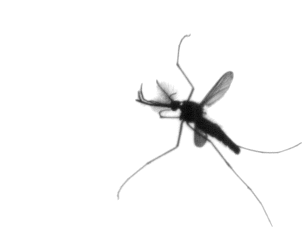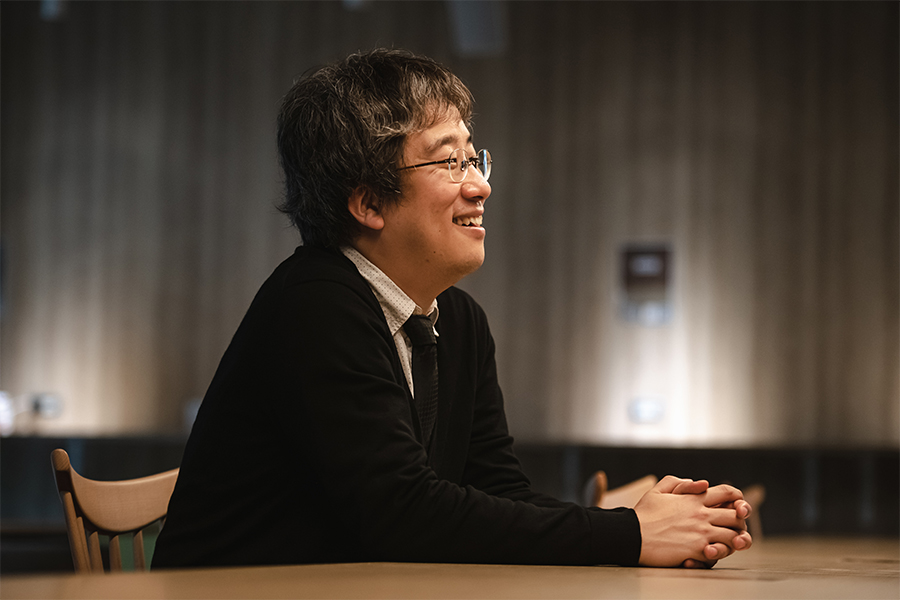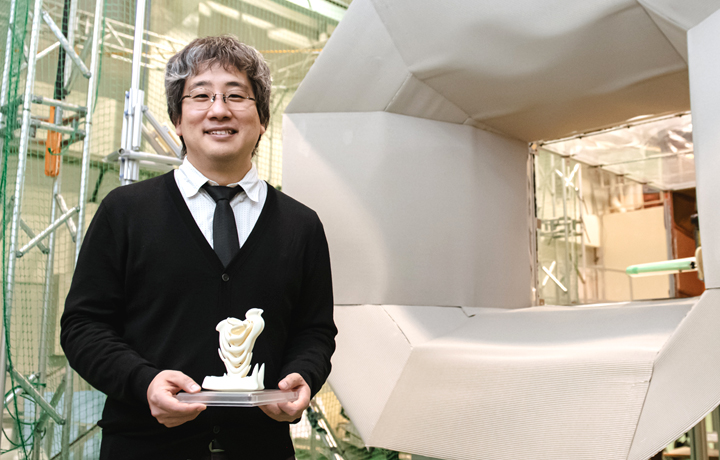Ever wondered why mosquitoes can effortlessly navigate through the darkness without hitting each other? Despite insects being familiar to us, understanding the complex movements of their wings and the reasons behind their collision-free fight is challenging for the naked eye. Associate Professor Toshiyuki Nakata of the Graduate School of Engineering has taken up this challenge, employing cutting-edge engineering technology honed in the UK. Associate Professor Nakata has garnered global recognition by publishing papers in leading journals such as Nature and Science, shedding light on the fascinating intersection of ‘the flight of living organisms’ and ‘engineering.’ In a discussion, he shares the joy of research that seamlessly blends these two realms, from the wing flapping of mosquitoes to the practical application of advanced drone technology.
Appreciating intricately moving machines and insects with equal fondness.

―Were you particularly interested in mosquitoes?
Not exactly. I find anything small that can fly intriguing. I’ve been fascinated by insects since childhood, but simultaneously, I’ve had a fondness for machines. If my parents mentioned throwing a blender, I would gladly take it and disassemble it. Insects and machines share the similarity of being intricate systems, with small components meticulously assembled to achieve complex and precise movements. I think I appreciated both insects and machines as entities boasting sophisticated mechanisms.
―Embarking on the path of research combining ‘Insects’ and ‘Machines.’
Back when I entered Chiba University, I never connected insects and my future aspirations. I majored in mechanical engineering due to my passion for machines and seamlessly joined the engineering laboratory during my master’s program at graduate school.
One day, as I passed by Professor Liu Hao in the hallway and exchanged a quick greeting, he nonchalantly asked me, “How are you?” Professor Liu is a leading researcher in the aerodynamics of insect flight. Thanks to the conversation that ensued from those words, I found myself accepted into Professor Liu’s laboratory for the doctoral course.
Since then, my fascination with the mechanics of insect flight has grown exponentially. Dr. Bomphrey’s group at the University of Oxford stood at the forefront of experiments and analysis in the field of biological flight. Eager to contribute to this cutting-edge research, I expressed my strong desire to conduct research in his lab. Professor Liu, understanding my enthusiasm, kindly introduced me to Dr. Bomphrey. Following a successful interview, I was honored to be hired as a postdoctoral research assistant.
―That was when you stepped into researching the observation of wing-flapping
Certainly, in the laboratory, we employed high-speed cameras to capture detailed images of various insects’ wing flapping and the airflow generated by these movements.
About a year into my research journey, a fascinating opportunity arose. Dr. Bomphrey received an intriguing email from another researcher suggesting, “I believe mosquitoes can fly without hitting each other even in complete darkness. Would you be interested in collaborating on this research?”
Upon hearing this proposal, I enthusiastically responded, “Let’s do it! It sounds exciting!” This marked the beginning of my exploration into the world of mosquitoes as research subjects.

However, as we delved into the research, we quickly realized that capturing a freely flying mosquito in the dark was a completely different challenge from photographing the wing movement by tethering a mosquito. Patience became a key factor in the process. Nevertheless, after numerous trials and errors, the final video successfully depicted the intricate details of its wing movement.
Engineering technology offers valuable insights to aid in understanding living organisms

―Why can mosquitoes fly in the dark without colliding with objects?
Mosquitoes don’t rely on sharp vision or ultrasound, like bats, to detect obstacles; they employ an entirely different method.
Mosquitoes generate airflow by flapping their wings, which induces the oscillation of the mosquito’s antenna. The airflow is disrupted when they encounter walls, floors, and other surfaces. As a mosquito approaches a wall or floor, the amplitude of the vibration of the antenna varies slightly. Mosquitoes possess special organs to detect subtle changes in the vibration of their antennae, enabling them to recognize that they are approaching an obstacle.
Armed with this knowledge, my colleagues replicated the mosquito’s obstacle detection system and developed a drone equipped with a sensor capable of detecting changes in air pressure when approaching obstacles.
―That is an example of ‘biomimetics,’ *a development of new technology inspired by biological mechanisms.
Indeed, there are various technologies that can draw inspiration from mosquitoes. For example, mosquitoes have a highly efficient sensing system that swiftly locates humans by sensing information such as carbon dioxide, scent, and moisture. Creating a drone equipped with mosquito-like antennae might enable the quick identification of victims in the event of a disaster.
However, speaking about airflow detection, despite knowing that mosquitoes have the ability to detect slight changes in airflow, it remains unclear whether mosquitoes actually use this ability to navigate around obstacles. Nonetheless, if a drone developed based on the airflow hypothesis could successfully detect obstacles, it is possible that mosquitoes employ a similar mechanism.
Biomimetics, also known as ‘Bio-inspired Technology,’ involves imitating biological tissues and functions for applications such as material development. On the other hand, ‘Robotics-inspired Biology’ entails building robots and conducting experiments to gain insights into the mechanisms employed by living organisms.
*An approach that imitates biological tissues and functions and utilizes them in material development, etc.
A drone emulating the airflow detection of mosquitoes possesses dual characteristics. It is this bidirectional interchange between engineering and biology that adds to the fascination of this field.
Envision the unseen with DIY experimental equipment

―I heard that most of the experimental equipment in your laboratory is crafted by you and your students.
When aiming to observe something that has never been seen before, existing equipment and software often fall short of fulfilling the specific requirement. Collaborating with students, we create custom equipment tailored for various purposes, such as facilitates for capturing images of mosquitoes and moths, a wind tunnel device for simulating artificial wind to study the flight of beetles, and equipment scaled appropriately for bird sizes.


―What are you trying to observe with a bird wing model set in the wind tunnel?
We are studying a robotic wing modeled after the kestrel, a bird known for its ability to utilize updrafts on sloping terrains, seemingly hovering in the air at a fixed point. Upon closely observing footage of a kestrel in flight, I found an intriguing phenomenon−―the feathers on its wings flipping over individually. This observation led to the development of a hypothesis suggesting a link between this feather movement and the kestrel’s distinctive flight.
To test this hypothesis, we affixed a thin sheet resembling a feather onto the surface of a wing model. Our objective is to observe how the sheet responds to wind and analyze the resulting airflow patterns. To perform this experiment, we’ve designed and built a device that allows us to tilt the entire wind tunnel. This capability enables us to replicate updrafts, providing a comprehensive understanding of the interplay between the feather-like sheet and the airflow.
I want to spread the infection of “Interesting!”
―Such experimental equipment is rare in the world, isn’t it?
As a researcher, my top priority is ‘to research topics that I find interesting.’ I aspire to be the first and the best researcher in the field globally. Take Dr. Bomphrey, for instance, who is one of the world’s foremost experts in studying insect flight and aerodynamics. This distinction opens up more opportunities to connect with other researchers and explore fascinating themes.

I aim to be ‘someone who creates interesting themes’ like him. By striving to be the best in the world, I hope to be ‘discovered by people with other interesting themes.’
‘Interesting’ is also an important keyword
I encourage my students to explore ‘interesting topics’ and ‘things they want to do.’ Despite this encouragement, many students find themselves at a standstill because they are unsure about what truly captivates their interest. I can relate to this feeling, as I used to perceive research as a serious endeavor until I went to the UK. It was there that Dr. Bomphrey, visibly delighted, exclaimed, “Look at those eyes! How beautiful!” as he examined the insects I had collected. Witnessing his genuine enjoyment made me realize “It’s okay to find joy in research.” This revelation eased the tension in my shoulders and broadened my horizons.

Consequently, when I come across something interesting, I make a conscious effort to share it with my students. Whether it’s the joy of catching numerous mosquito larvae in the pond behind the lab or the excitement of discovering the surprising beauty of familiar insects through the lens of a good camera, I openly express these experiences. The enthusiasm for photography is contagious, and students are buying cameras one after another (lol). Truly, insects boast remarkable aesthetics in their forms.

Recommend
-

Let Community-Based Disaster Reconstruction take roots
2022.12.20
-

Unveiling the Truth of the Universe through Simulated Catalogs: Unleashing the Power of a Theoretical Telescope, ‘Supercomputer’
2023.08.07
-

Live on the Moon, Settle on Mars: Research Center for Space Agriculture and Horticulture for Space Food Production and Supply
2023.10.20




